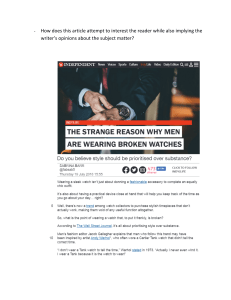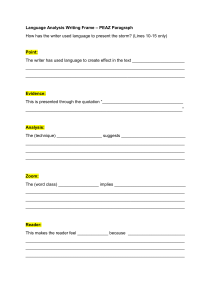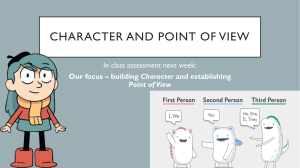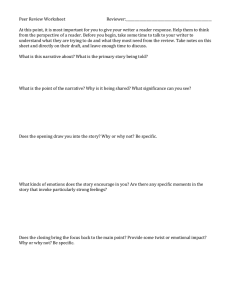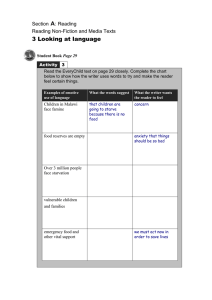Structural Features in Writing: Definition, Types & Examples
advertisement
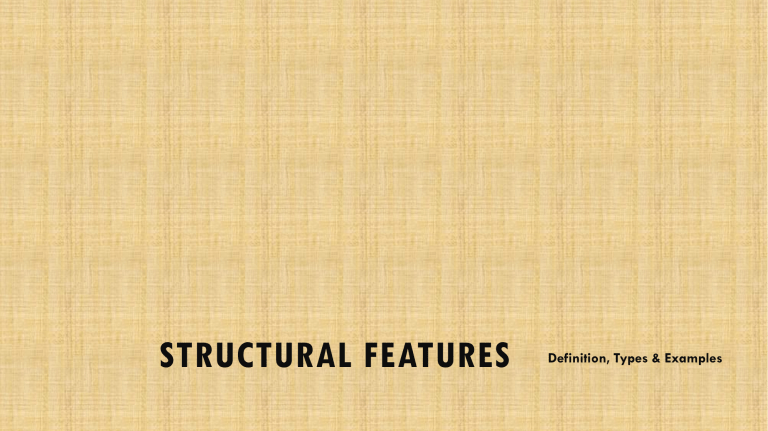
STRUCTURAL FEATURES Definition, Types & Examples STRUCTURAL FEATURES (DEFINITION) Definition A structural feature is anything the writer has done deliberately to shape or organise the text in a way that affects the audience. In other words, it is the way that a text is ordered and organised. Some types include: Point of View, Openings, Endings/Conclusions, Order of Events, Repetition or patterns, Dialogue, etc. STRUCTURAL FEATURE: POINT OF VIEW Point of view / Narrative Perspective - What viewpoint is the story or description told from? (first person, second person, third person: limited, omniscient, objective) First-person point of view is when the story is told from an individual point of view describing something that is happening to them. The key pronouns for first-person point of view are: I me my POINT OF VIEW (CONT.) Some examples of first-person narration: On my way to the grocery store, I saw a lone glove lying in the snowbank. Wondering if it belonged to someone nearby, I picked it up and put it in my pocket. I felt the track underneath my feet. It was dry and rocky. I could hear the crowd cheering. I was going to win! My friends were all down by the river by the time I turned up with my fishing rod and a bucket. They teased me for always being the last one to arrive. POINT OF VIEW (CONT.) Second-person point of view is a narrative that is told from the reader’s point of view. The key pronouns for second-person point of view are: you your POINT OF VIEW (CONT.) Some examples of second-person narrative: You walked to the corner, where you heard a telephone ringing in the phone booth. When you picked up the phone, there was no one on the other line. You always wanted to win the lottery, but you never thought it would really happen! There is something scary about the abandoned amusement park. Do you choose to enter anyway? POINT OF VIEW (CONT.) Third person point of view is not told from the point of view of the narrator or the reader. The key pronouns for third-person point of view are: they them their he/she/it his/hers/theirs POINT OF VIEW (CONT.) [ADVANCED] There are three different third-person points of view Third-person omniscient Third-person limited Third-person objective Third-person omniscient point of view means that the narrative is told from the perspective of a narrator who knows the thoughts and feelings of many characters in the story. Sometimes, third-person omniscient point of view will include the narrator telling the story from multiple characters’ perspectives. POINT OF VIEW (CONT.) [ADVANCED] Example of third-person narration: Darcy danced only once with Mrs. Hurst and once with Miss Bingley, declined being introduced to any other lady, and spent the rest of the evening in walking about the room, speaking occasionally to one of his own party. His character was decided. He was the proudest, most disagreeable man in the world, and everybody hoped that he would never come there again. (Pride and Prejudice, Jane Austen, 1813) *Third-person omniscient narration is common because it is the most versatile of the types of narrative point of view. It can show characters’ intimate feelings and create large, complex worlds. POINT OF VIEW (CONT.) [ADVANCED] While third-person omniscient shows us what many characters in the story are thinking and feeling, third-person limited point of view sticks closely to one character in the story. Using third-person limited point of view doesn’t mean you tell the story entirely from the one character’s perspective using I. That would make it first-person point of view. Third-person limited point of view can be more useful than the first-person point of view because you aren’t trapped in the character’s head. You can show both how they feel and what’s going on around them POINT OF VIEW (CONT.) [ADVANCED] In the series Harry Potter, most events are told from what Harry Potter sees, feels, and experiences. Otherwise, we would have known the whole time that Snape wasn’t entirely such a bad guy. Third-person limited point of view is useful when you want to deeply develop a reader’s relationship with one character. It can also be used to generate suspense by keeping a reader from knowing what other characters in the story know. POINT OF VIEW (CONT.) [ADVANCED] Some examples of third-person limited point of view: Jessie saw that Margaret was sobbing. The tears ran down her cheeks. He had no idea why she was so upset. The whole softball team was already on the bus when Max arrived. She was embarrassed and being late, she couldn’t find a seat. “Oh great,” she thought to herself. “Now everyone is going to know what a loser I am.” POINT OF VIEW (CONT.) [ADVANCED] Third-person omniscient and third-person limited points of view work to give you a certain insight into or empathy with a character or characters. The writer wants you to feel a certain way about them: he/she wants you to like them, or hate them, or trust them. Instead of creating a story in which the reader knows everything about what the characters think and feel, third-person objective point of view tells the story from the perspective of a total outsider. The reader has to judge the characters by their action and dialogue alone. POINT OF VIEW (CONT.) [ADVANCED] Some examples of third person objective are: The couple sat on the park bench, barely moving. They weren’t holding hands. The crickets chirped around them as they sat in the gathering darkness. Samuel took out a knife and the peanut butter. He spread the cream all over a piece of bread on the counter. There was no one else around. *Third-person objective point of view creates distance between the reader and the characters. It can also add an air of mystery. OPENING Opening The first line or paragraph of the text. -Is it exciting? If so, how? -What tone or mood does it set for the story or description? -Does it introduce anything important? -Why did the writer choose to open the text this way? **An opening sentence (which tells the reader what the general topic is) Captures the reader’s attention and draws them into the introduction. ENDING/CONCLUSION Ending/Conclusion The last line or paragraph of the text. -How do you feel at the end of the story? -Have your feelings changed since the opening of the story? -What last impressions does it leave us with? -What is the final tone, mood or feeling? -Are we shocked or surprised by anything? TASK Question: How has the writer structured the start of the text to interest you as a reader? "Marley was dead: to begin with. There is no doubt whatever about that. The register of his burial was signed by the clergyman, the clerk, the undertaker, and the chief mourner. Scrooge signed it: and Scrooge’s name was good upon ’Change, for anything he chose to put his hand to. Old Marley was as dead as a door-nail.“ *A Christmas Carol' by Charles Dickens FOCUS/FOCAL POINT Focus/ Focal point Zooming into a particular scene or detail -Does the writer focus on anything specific in one of the paragraphs or sections -What do they choose to focus on and why? -How does that detail contribute to the story/description as a whole? -Why did they want the reader to pay attention to it? e.g. The gloomy landscape implies an unhappy situation – what is causing that unhappiness? SHIFT (IN FOCUS) Shift in focus - Did the writer shift from one focal point to the next, or did he/she shift from a wide to a narrow focus? - Why did he/she do this? One example is starting a story in past tense and suddenly shifting into present tense: “Last week I was walking along a street when this man walks up to me and says . . . " TIME SHIFTS Time Shifts - What tense(s) does the writer use? - Is it past/present/future/conditional, etc.? - Why did the writer use a certain tense? - Why did he/she change the tense at some point? E.g.: Drunk driving is the leading cause of automobile accidents. Last year, more than 16,000 people died as a result of drunk driving. FOCUS (CONT.) Think about the world of the novel, first of all, everything the writer can focus your attention on falls into 1 of 3 categories: Setting (place and time) Characters (Dialogue and Action) Objects (something that will likely have significance later in the story) So then when the focus shifts, it will still fall into one of these 3 categories. It could shift from one setting to another setting; from one character to an object; from an object to another object and so on. They are completely interchangeable and there are no rules that a writer must move from one category to another. FOCUS EXAMPLE/TASK FOCUS (EXAMPLE CONT.) Let’s do the process of elimination. As we read, what do we find out about most? If it was setting, you should be able to say where all the action is taking place, what that place looks like, maybe the weather or even the time of day. If it was character then you could maybe tell the name/age, some further detail about the characters looks or thoughts or how others perceived them. If it was an object then it would be extremely detailed, you might be able to tell what the object is, the size, the colour, what others think of the object – and so on. What you should notice is that whatever the author focuses your attention on is the category you have the most information about. In this example, you could say the writer focuses our attention on characters, specifically Violet and Klaus. We know their age, that they are siblings, where they are and even what they thought. FOCUS (EXAMPLE CONT.) So we have identified our first structural feature, but we would want a little more depth as we only know the category, which would only show some awareness of structural features. Let’s look a little closer and consider what specifically we find out about the characters. You could say the writer focuses our attention on the whereabouts of Violet and Klaus and you would be correct because we find out that they are in a caravan on a high mountain path that they didn’t think they would be travelling on. However, if we look closer, is that the main idea the writer wants to get across? I think the main idea is more so the surprise of where they are than their whereabouts. FOCUS (EXAMPLE CONT.) Identify: The writer focuses our attention on characters Explain: The writer focuses our attention on Violet and Klaus Comment: The writer focuses our attention on Violet and Klaus’ whereabouts Analyse: The writer focuses our attention on Violet and Klaus’ reaction to their whereabouts and portrays that it was unexpected TEMPORAL REFERENCES Temporal references References to time - Temporal words are used to indicate the passage of time or describe the position of an event in time, usually through the form of a transitional preposition (e.g.: after, before, during, until) Let’s say a writer wants to tell someone about his or her day at school, and he or she wants to include the following list of information: Waking up • Arriving at school • Daily schedule • Favorite activity • Examples of topics talked about • Coming home TEMPORAL REFERENCE (CONT.) Since this is a personal narrative, the writer is aware of the specific details he or she wishes to include, but how would the reader know when these events happened? How does the reader know this isn’t a story about a week instead of one day? To make it clear that the story takes place throughout the course of a single day, the writer can insert temporal transition words and phrases to let the reader know the time frames in which the events happen. REPITITIONS OR PATTERNS Repetition or patterns When words, phrases or ideas are repeated for effect. - Repetition is used in poetry and prose to help make the writing more interesting and to help create patterns. -Depending on the word or phrase that is repeated, repetition allows for more emphasis to be placed on certain themes, ideas or objects. -Repetitive features can highlight key meanings, indicate development or show a lack of change. REPETITION OR PATTERNS (CONT.) For repetition to be noticeable, the words or phrases should be repeated within proximity of each other. Repeating the same words or phrases in a literary work of poetry or prose can bring clarity to an idea and/or make it memorable for the reader. Without repetition: 'The soup was stirred until thickened.' With repetition: 'The soup was stirred and stirred until thickened.‘ Common Examples of Repetition include: Time after time, Home sweet home, It is what it is Nursery rhymes e.g. Twinkle, Twinkle Little Star PACE Pace The feeling of speed in writing/ The speed at which a story is told. - Are events and ideas revealed to the reader slowly or quickly? - A slow pace builds tension or suggests boredom - A quick pace may suit a piece about things happening at speed ORDER OF EVENTS Order of Events The writing can be chronological (Chronological order is listing, describing, or discussing when events happened as they relate to time. Basically, it is like looking at a timeline to view what occurred first and what happened after that.) OR The writer might choose to start at the end, in the middle, or with flashbacks/flash forwards. ORDER OF EVENTS (CONT.) The order of events introduces and prioritises key ideas and how this engages the reader WITHHOLDING INFORMATION Withholding Information Clues and hints are given without revealing everything at once. - How does this build the reader’s expectations? **Instead of immediately telling the reader all at once what a character discovers when entering a suspenseful situation, the writer uses description to lengthen the moment and create tension. WITHHOLDING INFORMATION (EXAMPLE) As I stumbled up to the abandoned house, I shuddered. The wind screamed like a boiling kettle as the clouds grew darker and more ominous. Audacious strands of ivy covered every brick, clinging desperately against the walls. My heart pounded and every nerve in my body warned me to leave. Through the door I entered. I listened. I froze. Eerie sounds echoed among the cobwebs. Out of the corner of my eye, I noticed a shadow forming from under the door ahead of me. Fear left me helpless and I felt hypnotised as the door swung open… DIALOGUE Dialogue (Conversations and speech) - Dialogue can drive the plot forward. It can provide important information, reveal key events or developments, and introduce conflicts or resolutions. Conversations between characters often serve as catalysts for actions or decisions, shaping the trajectory of the story. - Dialogue helps to reveal and develop characters. Through their spoken words, characters express their thoughts, emotions, beliefs, and personalities. Dialogue allows readers or viewers to understand characters' motivations, conflicts, and relationships, which contributes to the overall structure of the story. DIALOGUE (CONT.) - Dialogue can create and intensify conflict and tension. Disagreements, arguments, or heated discussions between characters can heighten suspense, propel the narrative, and keep readers or viewers engaged. - Dialogue can establish the setting and atmosphere of a story. By incorporating details about the location, time period, cultural context, and social dynamics through character conversations, dialogue helps to situate the reader or viewer within the story's world. DIALOGUE (CONT.) Dialogue contributes to the unique voice and style of a narrative. Different characters may have distinct speech patterns, vocabularies, accents, or idiosyncrasies that reflect their backgrounds, personalities, or social status. These differences in dialogue contribute to the overall texture and tone of the story. DIALOGUE EXAMPLES Dialogue Example 1: "I can't take it anymore, Susan!" said John, frustration evident in his voice. "Calm down, John," Susan replied soothingly. "We'll figure this out together." In this example, the dialogue conveys John's frustration and Susan's calming nature. DIALOGUE EXAMPLES Dialogue Example 2: "I'm not going," Maria declared. "You know I can't just leave." "No one can ever leave this place," her friend agreed. **The subtext suggests that Maria's decision might be influenced by emotional attachments or responsibilities that prevent her from leaving her current situation. This style of characterization through dialogue adds more complexity to the story and allows readers to explore beneath the surface of the characters and the narrative. DIALOGUE EXAMPLES Dialogue Example 3: Tom said, “I have no intention of going to the party.” Sarah replied, “But it’s an important event, and I don’t want to miss it.” These lines demonstrate Tom’s reluctance, while Sarah values socializing and attending significant occasions. DIALOGUE (CONT.) TASK 1 “You'll never be good enough!" John shouted. "I'll prove you wrong," replied Ann with determination. TASK 2 "The treasure map was hidden inside the antique desk all along," said Laura "We must get to it before John discovers its location," added Peter urgently. ANSWERS FOR TASK 1 & 2 TASK 1 ANSWER: Through this exchange, readers can feel the opposition between John and Ann, creating anticipation for how their respective resolutions may unfold. TASK 2 ANSWER: Here, the dialogue naturally informs readers of the plot's progression without getting bogged down in lengthy descriptions. MONOLOGUE Monologue A monologue is an extended speech by a single character, either addressed to other characters or as an internal reflection. Monologues can be used to reveal a character’s motivations, provide a backstory, or deliver important information to the reader or other characters. MONOLOGUE EXAMPLES Monologue Example 1: As Richard gazed out the window at the city lights, he started talking, "This city… it's alive, constantly changing, evolving. It's seen me at my best and at my worst. It's been a silent witness to my triumphs and failures. It's here that I fell, rose, learned, and unlearned. The city, with all its chaos and calm, has been my teacher, my nemesis, my sanctuary. Living here is not just about surviving, it's about thriving amidst all odds. It's about finding a rhythm amidst the chaos and dancing to it." MONOLOGUE EXAMPLES Monologue Example 2: Seated at the edge of her bed, Lily began speaking to the room, empty save for her reflection in the mirror. "I have been many things in this life, worn many hats, played many roles. A daughter, a sister, a student, a friend, a lover, a worker. But through it all, the most profound journey has been discovering who I truly am, underneath these labels. Peeling back the layers, confronting my fears, my dreams, my flaws, my strengths. Realizing that I am not just what the world sees or expects of me. I am complex, unique, everchanging. And that, in itself, is a journey worth embracing." PARAGRAPH LENGTHS Paragraph Lengths They vary like sentences, for example, to highlight significant points or to provide a detailed account. They affect the development of the text. Example, a final paragraph might summarise key points in an argument. SENTENCE STRUCTURE Sentence structures affect the fluency of the text. For example, a sudden short sentence could reveal shocking information. -Did the writer use a deliberately long or deliberately short sentence? Why? -How does the structure of that sentence reflect the meaning? There are varied types of sentences -Simple sentence -Compound sentence -Complex sentence SENTENCE STRUCTURE – SIMPLE SENTENCE Simple Sentences A simple sentence has the most basic elements that make it a sentence: a subject, a verb, and a completed thought. Examples of simple sentences include the following: Joe waited for the train. The train was late. Mary and Samantha took the bus. SENTENCE STRUCTURE – COMPOUND SENTENCE A compound sentence refers to a sentence made up of two independent clauses (or complete sentences) connected to one another with a coordinating conjunction. Coordinating conjunctions are easy to remember if you think of the words "FAN BOYS“ For And Nor But Or Yet So COMPOUND SENTENCE (CONT.) Examples of compound sentences include the following: Joe waited for the train, but the train was late. I looked for Mary and Samantha at the bus station, but they arrived at the station before noon and left on the bus before I arrived. Mary and Samantha arrived at the bus station before noon, and they left on the bus before I arrived. Mary and Samantha left on the bus before I arrived, so I did not see them at the bus station. COMPLEX SENTENCE A complex sentence is made up of an independent clause and one or more dependent clauses connected to it. A dependent clause is similar to an independent clause, or complete sentence, but it lacks one of the elements that would make it a complete sentence. Examples of dependent clauses include the following: because Mary and Samantha arrived at the bus station before noon while he waited at the train station after they left on the bus HOW DO WE ANALYSE STRUCTURE IN A TEXT? 1. First, underline the focus of the question - make sure the points you make link back to this. Keep referring back to the question in your response (‘the writer structures the text…', 'this would interest the reader because…’). 2. Consider: a) What happens at the beginning of the extract? Why does the writer start it like this? What is the effect? b) What does the focus shift to in the middle of the extract as the extract develops? Why? What is the impact of this? What is the effect on the atmosphere, pace or tone? HOW DO WE ANALYSE STRUCTURE IN A TEXT? (CONT.) c) What happens at the end of the extract? What is the effect of this? What is the impact on the reader? 3. Use structure terminology (shifts, focus, develops, repeats, pattern, contrast, narrative pace, foreshadows). 4. It’s useful to picture the section as if you were watching it. Ask yourself: How does the scene change through the extract? HOW DO WE ANALYSE STRUCTURE IN A TEXT? (CONT.) 5. Think about the setting and characters: Does the extract start inside/outside? Are there characters present? When and how are they introduced? Is there a similarity with how the extract starts and finishes (this could be referred to as a cyclical structure as it starts and ends in a similar format. KEY FEATURES TO LOOK FOR... 1) Short sentences (often used to describe fast-paced action or to highlight a particular idea) 2) Longer sentences (used for lengthy descriptions, vivid imagery or to depict an ongoing moment of action) 3) Paragraphs – short or long (have a similar effect as sentence structure. Can create a tone of panic or ease) 4) Punctuation - (e.g. ellipsis in dialogue may suggest that a character isn't saying everything that is on their mind) KEY FEATURES TO LOOK FOR... (CONT.) 5) Characters - (what descriptions are there? What can we infer about their qualities, Do we like them?) 6) Dialogue - (what do they say? What language do they use? Is this chosen for a reason?) 7) Time changes - (e.g. Flashbacks or flash forwards, a change in location, a move from interior to the exterior or vice versa) FORMING YOUR RESPONSE Firstly, the writer focuses on… The focus then shifts to… The writer repeats the idea of… The narrative pace increases when… The writer is foreshadowing… This is effective because… This makes the reader feel… This emphasises to the reader… This interests the reader because… GROUP TASK The following text is from Charlotte Perkins Gilman’s 1910 poem “The Earth’s Entail”. No matter how we cultivate the land, Taming the forest and the prairie free; No matter how we irrigate the sand, Making the desert blossom at command, We must always leave the borders of the sea; The immeasureable reaches Of the windy wave-wet beaches, The million-mile-long margin of the sea. GROUP TASK (CONT.) Which choice best describes the overall structure of the text? A. The speaker provides examples of an admirable way of approaching nature and then challenges that approach B. The speaker describes attempts to control nature and then offers a reminder that not all nature is controllable. C. The speaker argues against interfering with nature and then gives evidence supporting this interference. D. The speaker presents an account of efforts to dominate nature and then cautions that such efforts are only temporary. INDIVIDUAL TASK Being a clown isn’t all fun and games. Rodeo clowns expose themselves to great danger every time they perform. When cowboys dismount or are bucked off of bulls at riding competitions, rodeo clowns jump in front of the bulls and motion wildly to get their attention. In this way rodeo clowns provide an alternate target, and in doing so protect the rider. So you see, sometimes clowning around can be serious business. Write a sentence explaining the main idea of the text. Create a title for the passage related to the main idea. List some structural features that have been used in the passage. GROUP TASK/HOMEWORK English Learner’s Book Year 8 (pgs. 11-13) Question 4 & 5

